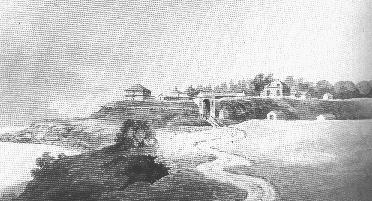


In command of these British defenses at York was Major General Shaeffe, who had won the final battle after Brock's death at Queenston Heights. He had been sick during the winter, however, and here he had no more than seven hundred men, about half of them were local militia. He kept most of his force inside the unfinished fort, waiting for the proper moment to counter attack the invaders. The landing began about 8 a.m. on the morning of April 26th and soon four companies of U.S. infantry were ashore. With them came Brigadier General Zebulon Pike, second in command of the American military force.
The British counter attack, as a result of confusion on the part of the defenders, was made by only one company, the grenadiers of the King's Regiment, a picked company of one of the best British regiments. Their bayonet charge reached the beach; one American officer stepping from a boat was bayoneted in the shoulder. But it was one company against four, with more Americans landing; the grenadiers, their company commander dead and many others dead or wounded were forced to retreat toward the town. General Shaeffe had lost control of his command; three other companies arrived piece meal on the battlefield and were defeated one at a time.
The American force advanced along the beach with the support of naval gunfire from Chauncey's ships. Pike's field guns were landed and opened fire on the British positions. The local militia began to fade away from the defensive works. General Sheaffe decided to withdraw his regulars. Leaving the flag flying over the fort, he marched his men away toward Kingston, advising the militia commanders to make contact with the Americans and get the best terms for surrender they could. He sent sent to set fire to a war ship under construction in the harbour and to blow up the poweder magazine.
By then the Americans were at the edge of the fort. Because it's flag was still flying they thought it was still garrisoned- which of coarse was Shaeffe's reason for leaving the flag there. General Pike was questioning a captured British sergeant when the stone magazine blew up. One witness said that the building rose slowly, assuming the shape of a vast balloon; then out of the balloon-shaped cloud huge stones and wooden beams began to rain down on the nearby Americans. General Pike's back and chest were crushed, twenty-eight of his men were killed outright, and over two hundred were wounded.
General Pike was carried out to Chauncey's flagship, the new U.S.S. Madison, where he died. General Dearborn landed and took personal command ashore. The Americans occupied the town of York for five days and before leaving burned the buildings left in the fort and burned all the parliament buildings in town.
CLICK HERE to see the monument for Fort York.